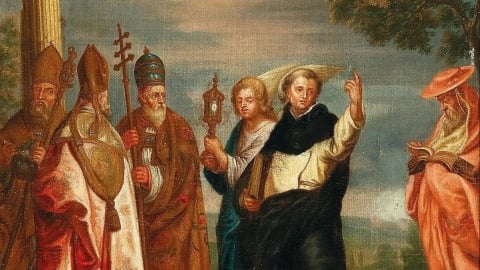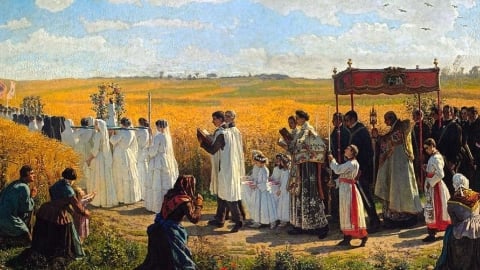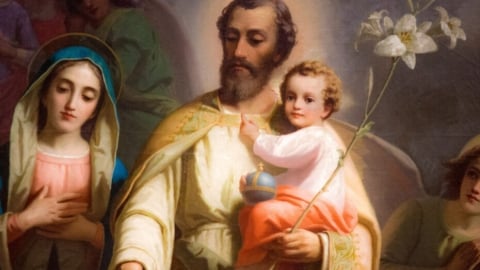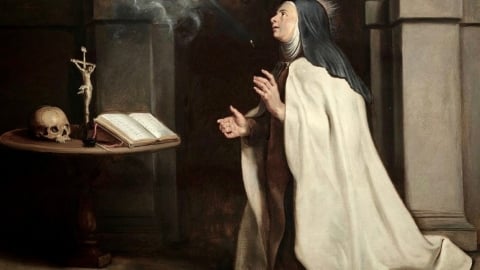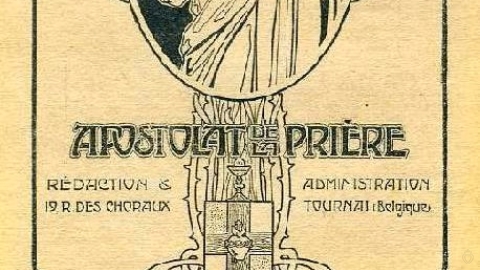Saint Pius X: Model for Priests - I

Joseph Sarto, the future Pius X, always wanted to be a priest. As early as he could remember he would say, “Mother, I wish to be a priest.” With a pious mother’s innate reliance on divine help, she always nodded assent even the while she looked over her large and growing family and thought of the small earnings of Signor Sarto from his small farm and his modest position as caretaker for the little municipality of Riese.
Joseph Sarto was born on Jan. 2, 1835, in a family of eight. He was barely eleven years of age when he trudged the long road to Castelfranco to attend its Latin school and prepare for the priesthood. The years sped by. In November 1850 the youth, already tried by difficulties and proved by diligence and hard work, was given a scholarship to the seminary at Padua. He was a bright pupil, apt and capable of long hours of study, and he led his class throughout his years in the seminary. During the summer vacations the seminarist took up some gainful work in his native village, helped the pastor during the day and taught the catechism to children and youth during the evening hours. Going about in his plain black cassock, which marked him apart from his friends and neighbors, the young Levite exemplified for all to see the simple unaffected virtues of the Boy of Nazareth in Joseph’s workshop.
John Sarto, head of the family, died in 1852 while his son was still in the seminary. It was a hard blow for the young student, and he felt obliged to remain at home and help support his widowed mother and her young family. But she would not hear of it. “We’ll get along,” she said. From the seminary Joseph Sarto wrote, “Here I read and work and prepare myself for the life of solitude and study that will be mine as a priest.” He was given charge of the classes in ecclesiastical chant during his last year and was made director of the seminary choir. At length, on Sept. 18, 1858, in the ancient cathedral of Castelfranco, Joseph Sarto was ordained by the Bishop of the diocese of Treviso.
CURATE AND COUNTRY PASTOR
Father Sarto, not unlike many a young priest before and since, spent a few weeks at home in Riese and then received his appointment as curate in the run-down little village of Tombolo. The pastor was an excellent priest of high ideals and unaffected simplicity, but his health was not good. The young curate plunged into the work with fresh zeal and energy. There was so much to do; so little time to do it! Then began a constant round of duties: preparing his sermons, instructing the children, looking after the sick, helping the poor. A niece of the pastor testified before the Roman commission on the beatification process that Father Sarto was “in a constant activity.” When asked if he ever slept, he calmly replied that four hours were usually sufficient for him. The janitor of the church would find him already in the sacristy when he went to open the church at sun-up, and the villagers would see their young priest in the dark shadows of the sanctuary late at night wholly rapt in prayer. Father Constantine, the pastor, wrote of him, “I had orders to mould this young assistant to the duties of a parish priest; in fact however the opposite is true. He is so zealous, so full of good sense, and other precious gifts that it is I who can learn much from him.” And then this gentle and wise old man indulged in a bit of prophecy which is startling in the light of future events. “Some day or other he will wear the mitre; of that I am sure. After that-who knows?”
Farther Sarto spent nine busy years in Tombolo and the time was already past for a change. It was not his suggestion but the Bishop’s which prompted him to take an examination for the large and important parish of Salzano. On May 21, 1867, the appointment came for the young pastor then thirty-two years old, but much to the ill-concealed chagrin and disappointment of the people of Salzano. The aristocratic surroundings and traditions of this ancient city had always been graced by pastors of gentle birth who were as a matter of course honored canons of the cathedral. An outraged committee from the parish waited upon the Bishop to clear up what they said was a “manifest injustice.” Very quietly the Bishop announced, “I am giving you the curate of Tombolo as your pastor.” Then he added, “In this I am doing Salzano a great favor.”
The first Sunday in the parish was one of suppressed excitement and expectancy. The church was filled to capacity with those of low and high degree. The pastor ascended the pulpit and briefly spoke of the work which he planned to do in the parish. In a few rapid but effective strokes he dispelled all their prejudices. A visitation of every home in the parish followed, and the warm personal charm and simplicity of the young pastor won the hearts of all.
A MODERN PASTOR
There is something of our own time in the way Father Sarto attacked the problems of his parish. He saw at once a desperate need for religious instruction. He himself conducted catechism classes for children and for youth; and for adults he explained the Gospel and the simple rudiments of the faith on each Sunday and holyday. He insisted on attendance at instructions in lieu of devotions. “What will the devotions of the Church profit you if you do not understand their meaning?” he said. “And how can you understand the homilies and sermons if you are ignorant of the primary and most necessary truths?” He introduced the method of dialogue instruction in the church on Sunday evenings. A priest from a neighboring parish and Father Sarto occupied separate pulpits in the sanctuary from which they could discuss points of doctrine and answer each other’s objections against the faith which were current at the time. This novel teaching technique attracted large crowds of people, many of whom came from nearby cities and villages. Some neighboring pastors complained to the Bishop that their churches were empty on Sunday evenings because of Father Sarto’s popular instructions. “Go and do thou likewise,” was the Bishop’s rejoinder.
In a few years the parish of Salzano was known as the best organized in the diocese. The pastor believed in giving the people every kind of service. There was the Confraternity of the Blessed Sacrament with its devotion of the Forty Hours. Father Sarto preached and counseled frequent Communion for adults and early First Communion for little children when such practices were unknown—a presage of the future Decrees of Pope Pius X! There was a society of the Sacred Heart in the parish, and a sodality of the Blessed Virgin with special solemnities during the month of May. He organized the Confraternity of Christian Doctrine and saw to the training of its teachers and parish leaders. In keeping with his life-long love for the liturgy, Father Sarto organized and trained a choir of young men to sing during the divine services, and he saw to it that the ceremonies of the Church and its liturgy were carried out with dignity and precision. The church itself was newly decorated every few years and he kept both church and rectory in simple yet adequate order and repair.
The pastor of Salzano took a keen interest in the economic and social conditions of his parish. A large silk factory which employed more than three hundred women and a large number of men was located in the city. The owner and the pastor were on friendly terms and it was due to the latter’s influence that employer-worker relations were always harmonious. To obtain the most favorable prices for produce of the farms, Father Sarto advised his farmers on what to grow, and when to sell. He set up a local banking system for loans and credit and he took a leading part in protecting his people against extortionate landlords.
The pastor’s study was open to the public night and day. He met all with a welcome smile. The poor of the parish and the sick and unfortunate were the special concern of his great heart. “Everything I have,” he said, “is theirs.” Father Sarto’s two sisters were his housekeepers. They complained that they could keep nothing of value in the house, not even food! All went to the poor and to the first suppliant that knocked at the pastor’s door. His greatest joy was in giving. At the bedside of the sick he was a consoling angel. Indifferent to personal danger in the cause of the sick, the pastor frequently risked his life, especially during the great epidemic of cholera which swept the country in 1873.
The parish of Salzano was transformed in the space of less than nine years. The Bishop’s prediction came through. When he was about to bring Father Sarto to the See city of Treviso, he wrote as follows: “A wonderful religious spirit flourishes in the parish; there is a happy community all united around their holy and devoted pastor.”
UBI HONORES, IBI ONERA
On the morning of Sept. 17, 1875, the pastor of Salzano set out for Treviso. To avoid a painful leave-taking he departed early before any of his parishioners were about. He could look back over eighteen years of faithful labor, unheralded by any self-sought publicity. Now high honors and heavy responsibilities awaited him. He was appointed chancellor of the diocese, canon of the cathedral chapter, and spiritual director of the diocesan seminary, where he took up his abode.
Canon Sarto at once assumed the duties of the chancery office. Owing to the poor health of Bishop Zinelli, he practically ran the diocese. As spiritual director, he took the seminarists to his heart and gave them fully of his time and experience. “I am only a poor country pastor,” he told them, “and I have this place only by God’s holy will.” The work meant regular conferences, confessions, and spiritual advice and counsel at all times. As canon of the Cathedral, he faithfully carried out its duties. Despite all these weighty charges, Canon Sarto continued his interest in the religious instruction of the people. He organized catechism classes for the youth attending public schools from which all religious instruction was banned; and on Sundays he taught groups of students the principles of good citizenship as he prepared them for reception of the Sacraments. The vice-rector of the Seminary protested one day that the Canon should relinquish the work of teaching children because of the pressure of so many tasks. “It is my duty, am I not their father?” was the answer, which is reminiscent of a similar reply of the great chancellor of the University of Paris, John Gerson, on being told that teaching children their catechism was beneath his dignity.
Canon Sarto displayed a perfect balance between a high seriousness demanded of his many offices and the lighter side of his character. This was apparent in his life at the seminary where his confreres attested to his charm, his jokes, quick repartee, and general pleasantry. When after four years, he was made vicar general of the diocese in 1878, all felt that higher honors were in store. Yet in him was no trace of human ambition. He felt too keenly the sacred calling of the priesthood. “The priest,” he told the seminarians, “lives in a permanent state of war against the forces of evil.” He looked upon those who aspired to the glory of insignia and color with a smile of indulgent compassion.
One day, after nine years had passed in Treviso, the Bishop summoned his chancellor and led him to the little chapel. There together they prayed for some moments. The Bishop then handed over a letter of appointment to be Bishop of Mantua. Canon Sarto turned pale and refused at once to accept the tremendous responsibility. Again, on Nov. 13, 1884, he knelt before Leo XIII and begged to be relieved of the appointment. “You have written a letter asking to be dispensed from the bishopric,” the Pontiff told him. “But it is Our wish that you go to Mantua.” Writing later of his failure, the Bishop-elect cried out, “What a cross! What a calvary!”
